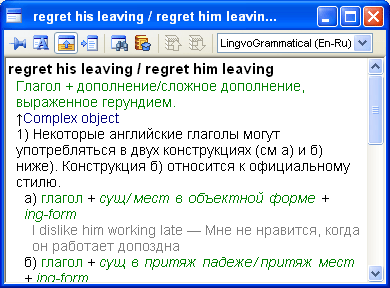
Show me a grammar
entry


Starting from version 8.0, ABBYY Lingvo includes an electronic grammar reference book on its Bookshelf, LingvoGrammatical (En-Ru). The dictionary contains about 500 entries which cover:
- Major grammar topics;
- Common grammatical patterns and differences (if any) between similar constructions such as give me this and give this to me;
- English usage, including differences between British and American English.
The root article is Grammar, which links to six major articles: Parts of speech; Syntax; Speech situations; American and British English; Spelling; Punctuation. These entries provide links to entries which treat related grammar topics in detail. A grammar entry contains a link to its mother entry and may also contain links to child entries and related entries.
You can use LingvoGrammatical just like any other dictionary on the Bookshelf. Note, however, that cards in this dictionary provide not translations of headwords but descriptions of the grammatical phenomena that they name.
You can access LingvoGrammatical either by clicking links to its entries in some LingvoUniversal (En-Ru) cards, or simply by opening its root entry, Grammar, and browsing it as a hyperlinked electronic reference.